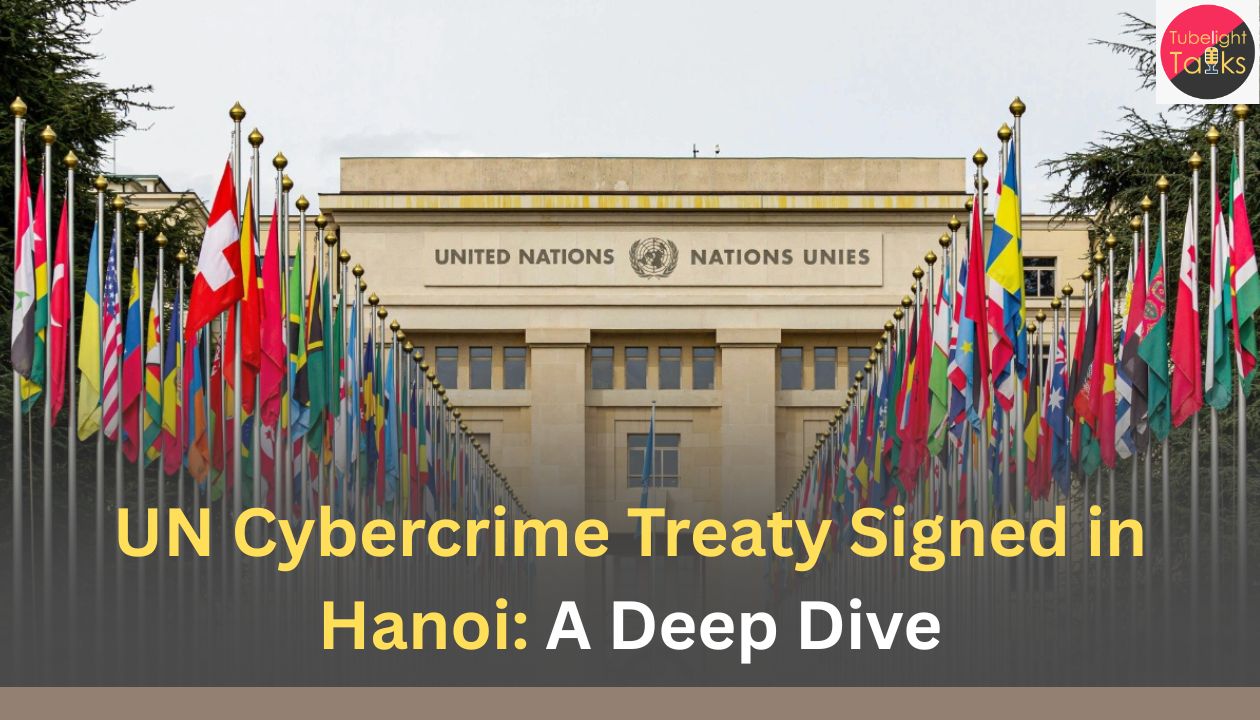UN Cybercrime Treaty Signed: Cybercrime has become a multibillion‑dollar, borderless threat affecting governments, individuals and businesses worldwide. With two‑thirds of the global population online, malicious digital activity—from ransomware to phishing to trafficking—poses systemic risks. In response, the United Nations General Assembly adopted the Convention on Cybercrime on 24 December 2024 under Resolution 79/243.
What’s New
The treaty is the first universal legal instrument of its kind in over 20 years, marking a shift from regional frameworks (such as the Budapest Convention) to a globally‑inclusive model. The treaty will open for signature on 25–26 October 2025 in Hanoi, Vietnam, and afterward at UN Headquarters in New York until 31 December 2026.
Key Features of the Convention
Scope of Crimes
The treaty requires signatories to criminalise a range of cyber‑dependent offences (for example: illegal access, data interference, system interference) and a limited set of cyber‑enabled crimes (such as fraud committed using ICT systems).
International Cooperation Mechanisms
It mandates expedited data preservation orders, mutual legal assistance, 24/7 points of contact, and mechanisms to share electronic evidence across borders.
H3: Human Rights & Capacity Building Provisions
The treaty emphasises inclusivity, offering support to states with limited resources to build digital‑investigation capacity. It claims to safeguard human rights by referencing existing UN human‑rights instruments rather than creating new standards.
Reactions & Stakeholder Perspectives
Support and Momentum
Officials consider the treaty a landmark in global governance, with UN Secretary‑General António Guterres calling it a
“powerful legal instrument to strengthen our collective defences against cybercrime.”
About 60 countries were expected to sign during the Hanoi ceremony, signalling strong global buy‑in.

Human Rights and Tech‑Industry Concerns
Civil‑society groups, cybersecurity companies and digital‑rights advocates caution that the treaty’s broad language may enable government overreach, surveillance, censorship and criminalisation of ethical hacking. Some firms, including major tech platforms, have described it as a “surveillance treaty”.
Implications for Global Governance & Nations
For Developing Countries
The treaty offers an opportunity for capacity building, technical assistance and more equitable participation in global cyber‑governance. It may raise national standards for investigation and cross‑border cooperation.
For Tech Companies & Innovation
Global software firms may face new legal workflows as digital‑evidence requests, cross‑border data access and standardized cooperation across jurisdictions become easier. They must also navigate varying national interpretations of crime definitions under the treaty.
For National Security
Countries may deploy the treaty as part of national cybersecurity strategies—strengthening defences, harmonising legal frameworks, and coordinating with international partners against advanced threats like ransomware and state‑linked cyber operations.
Challenges & What Lies Ahead
Ratification and Implementation
The treaty will enter into force only after 40 countries ratify it and deposit the instruments of ratification, after which it will become binding 90 days later. Domestic law‑making, coordination among law‑enforcement, data‑protection frameworks and infrastructure remain key hurdles.
Balancing Security and Rights
Implementation will test how states reconcile enhanced cyber‑investigation powers with protections for freedom of expression, privacy and due process. Experts emphasise robust safeguards and oversight.
Technical & Operational Realities
Cross‑border digital forensics, evidence preservation, mutual‑legal‑assistance workflows and skilled staffing remain resource‑intensive, especially in low‑capacity states.
Risk of Fragmentation
If major powers diverge on participation, or impose conflicting standards, the global cyber‑governance architecture may fragment rather than integrate, reducing effectiveness.
Also Read: Cybersecurity Threats and Data Privacy in the Digital Age
Digital Protection & Collective Responsibility
In an age of deepening digital integration, the teachings of Sant Rampal Ji Maharaj emphasise that real progress isn’t just about having power or control—it’s about responsibly using tools to uplift humanity, safeguard dignity and foster cooperation. As states unite to sign a global cyber‑crime treaty, the satgyan‑inspired perspective prompts reflection: Will digital security serve not just national defence, but the protection of all people’s rights and freedoms? True digital governance that honours satgyan ensures that technology, law and society move together with fairness, respect and service‑oriented purpose.
What to Watch
Ratification Trends & Major Signatories
Which countries will ratify first? Will major powers such as the U.S., China and the EU fully commit, and when?
Implementation Monitoring
Will states publish transparency reports on how their national laws change, how digital‑evidence workflows operate, and how human‑rights safeguards are upheld?
Industry Adaptation
How will global tech firms adjust to new legal frameworks under the treaty? What standards, compliance regimes and cross‑border workflows emerge?
Civil Society & Rights Oversight
How will NGOs, digital rights groups and independent monitors respond to implementation? Will concerns of surveillance, censorship or rights erosion be addressed?
FAQs: UN Cybercrime Treaty
Q1. What is the UN Cybercrime Treaty?
It is formally titled the United Nations Convention against Cybercrime: Strengthening International Cooperation for Combating Certain Crimes Committed by Means of ICT Systems and for the Sharing of Evidence in Electronic Form of Serious Crimes. It was adopted by the UN General Assembly on 24 December 2024.
Q2. When and where is it being signed?
The ceremony takes place in Hanoi, Vietnam on 25–26 October 2025, followed by an open signature period at the UN Headquarters in New York until 31 December 2026.
Q3. When will it enter into force?
Once at least 40 states ratify it and deposit their instruments of ratification. After that, it becomes binding 90 days later.
Q4. What types of crime does it address?
It covers cyber‑dependent crimes such as illegal access, data and system interference, and a limited set of cyber‑enabled crimes (e.g., fraud via ICT) plus provisions on evidence‑sharing and cooperation.
Q5. What are the main concerns?
Human‑rights and digital‑rights advocates warn that the treaty’s broad scope and vague terms may enable surveillance, restrict freedom of expression or criminalise legitimate research or hacking.










